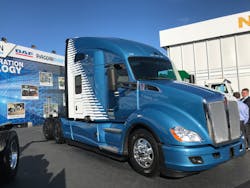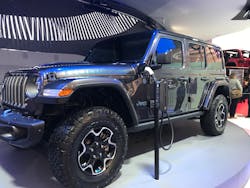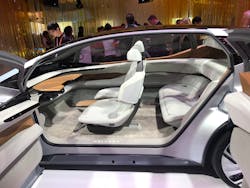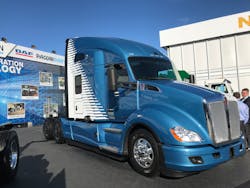Top themes from the transportation industry at CES 2020
From electrification to autonomous concept vehicles and beyond, the future of mobility was hard to miss on the show floor or in conference halls.
The Consumer Electronics Show (CES) is known as the global stage for innovation. Held in Las Vegas each year, the show features over 4,400 exhibitors and draws in 170,000 attendees. It is undoubtedly the largest technology event in the world.
Innovations from all industries were represented, and the transportation industry had an impressive presence. It didn’t take long when walking the floor to notice the future of mobility is emerging fast. In fact, at times it felt as if George Jetson was going to make an appearance.
Automotive and heavy duty manufacturers including Ford, Hyundai, Honda, Daimler, Toyota, Paccar, and more filled the exhibit floor with their latest products and technologies. In addition, more than 150 vehicle technology exhibitors showcased their latest developments.
The technology and future developments were not only found on the floor, but also talked about in conferences that were held throughout the show. Topics ranged from smart cities, connectivity, and cybersecurity, to the challenges and opportunities of future transportation (such as electrification and vehicle autonomy).
Here are some key themes and takeaways from the transportation industry at CES 2020.
Electrification
In a panelist discussion on electrification, experts agreed that education is the top concern when it comes to electric vehicles. Electric vehicles are proven to be a cleaner and more efficient means of travel; however, consumers are not aware of the all capabilities and possibilities.
“There is a total confusion about electric vehicles,” said Ted Cannis, global director of electrification at Ford Motor Company. “They don’t know; the education side of this is massive.”
One main concern is charging. Many people prefer charging from the comfort of their homes and are unaware of where else they can charge or if there is another place to charge while they are out on the roads. Large cities offer multiple options, however rural areas are still a lacking a comprehensive charging infrastructure.On the exhibit floor, electric vehicles were abundant including Jeep’s plug-in hybrid Wrangler Rubicon, Ford’s Mustang Mach E, Nissan’s Ariya SUV, Chrysler’s Airflow Vision, and Sony’s Vision-S concept car.
Cybersecurity
As technology and connectivity increases within vehicles, the concern for cybersecurity continues to rise. This is especially true as software is required to be updated over the lifecycle of the vehicle.
During a panelist discussion, stakeholders shared the importance of automotive manufacturers and industry leaders working together to ensure cybersecurity during a time of electrification, connectivity, and autonomy from new mobility models.
“It’s important to know that the automotive industry is taking this subject [cybersecurity] very seriously,” said Faye Francy, executive director at Auto-ISAC. “We must all work together; it’s imperative.”
Francy noted that starting five years ago, 14 OEMs began working together to put forth a guide of best practices for cybersecurity. It now includes 57 members across the transportation ecosystem including automakers, suppliers, and auto industry stakeholders.
Aside from security from the point of conception, it was also reminded that users should be aware and remain educated on any potential risks.
Vehicle autonomy
The ultimate goal for many manufacturers is driverless vehicles. With advancements in advanced driver assistance systems (ADAS) including LiDAR and other sensors, the future of autonomous vehicles just might be approaching sooner rather than later. Like electric vehicles, autonomous concept cars and heavy duty trucks took the exhibit floor by storm.
Audi’s AI:ME, Honda’s Augmented Driving Concept, and Paccar's Level 4 autonomous Kenworth T680 were all present, to name a few.
One concept car that turned many heads was the Mercedes-Benz Vision AVTR. The company teamed up with James Cameron, director of the 2009 film, Avatar, to create the futuristic car with the goal to merge human and machine. The Avatar-inspired car features scale-like flaps on the outside to mimic an animal and is controlled by a touch pad located on the center console.
During a panel discussion, the concern of educating the public on the benefits and possibilities of autonomous vehicles was brought up. Maya Pindeus, CEO of Humanizing Autonomy, said it is an exciting time and it’s not just about the car, but also about implementing services such as for the elderly and disabled.
Though it may be some time before autonomous vehicles hit the road, safety and educating the public will remain top priorities for manufacturers and government policy.
Toyota’s Woven City
Akio Toyoda, president and CEO of Toyota, revealed the company’s plan to build a “living laboratory” called the Woven City. The city will break ground at the base of Mount Fuji in Japan beginning as early as 2021.
What makes this city so unique? It will be powered by Toyota’s hydrogen fuel cells and will be home to full-time residents and researchers working to develop future technologies including smart homes, robotics, personal mobility, and artificial intelligence (AI).
“With people, buildings, and vehicles all connected and communicating with each other through data and sensors, we will be able to test AI technology in both the virtual and the physical world, maximizing its potential,” Toyoda said.
It was also noted that only fully autonomous and zero-emission vehicles will be allowed for residents to use.
Conclusion
The transportation industry certainly stood out this year at CES. It was impressive, it was large, and it was impactful. The future of mobility is, without a doubt, keeping many manufacturers and aftermarket companies on their toes. It’s an exciting time for transportation.
About the Author
Kayla Oschmann
Assistant Editor | Vehicle Repair Group
Kayla Oschmann is assistant editor for the Vehicle Repair Group.
With an education in journalism and public relations, Oschmann contributes to Fleet Maintenance, PTEN, and Professional Distributor magazines, as well as VehicleServicePros.com.




